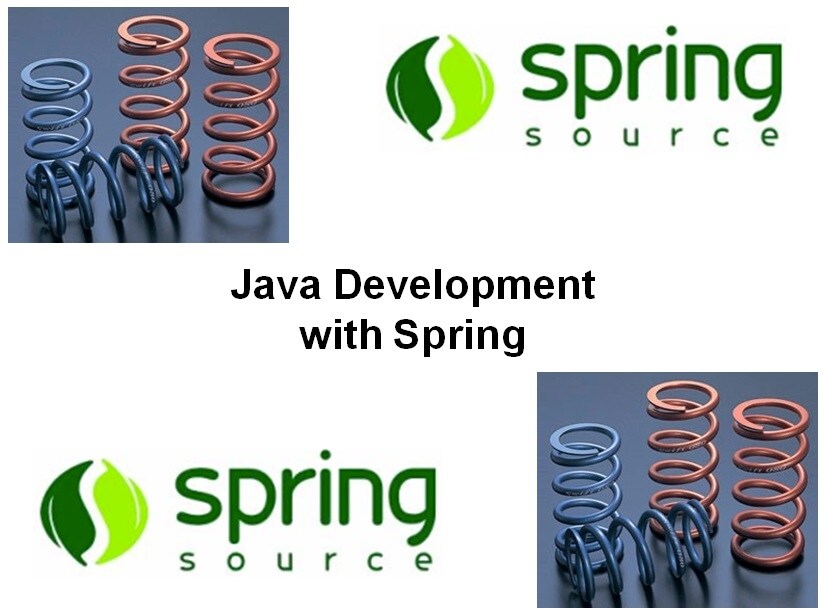-
Learning by doing
-
Trainers with practical experience
-
Classroom training
-
Detailed course material
-
Clear content description
-
Tailormade content possible
-
Training that proceeds
-
Small groups
The course Java Development with Spring covers the concepts, components and architecture of the Spring Framework. The course is done with the latest Spring version with Spring Boot. In the course, annotations are central to the configuration of the Spring Applications.
The course Java Development with Spring starts with an overview of the different parts of Spring and the types of applications in which Spring can be used.
Next the essentials of Spring Boot, which greatly simplifies the configuration of Spring applications, are discussed. The main Spring Boot annotations, the opiniated defaults and the built-in web servers are treated.
Attention is paid to the concept of Dependency Injection or Inversion of Control which plays a central role in the framework. Different variants of dependency injection such as setter injection and constructor injection are discussed.
The other pillar of the framework, Aspect Orientation, is also covered in detail. The concepts of Aspect Orientation such as Aspects, Joinpoints, Pointcuts, Advice and Weaving are explained.
Next the different options for storing the data of Spring Java applications in databases are discussed. Attention is paid to the use of JDBC with a JdbcTemplate, as well as the use of Object Relational Mapping frameworks such as Hibernate with a HibernateTemplate or JPA via annotations. Spring Transactions are also treated in this context.
Web Applications with the Spring MVC Framework are part of the program of the course Java Development with Spring as well as the creation and use of Spring Rest Web Services. The role of controllers, views, page parameters and command objects is explained.
Finally attention is paid to Spring and Security and the simplified setup of a Spring configuration with Spring Boot is treated. The modules Spring with JMS and Spring with JMX are optional.
Experienced Java developers who want to use the Spring Framework for Java Desktop, Web and Enterprise applications.
Experience with Java programming and object orientation is required to participate in this course. Basic knowledge of Web Applications and XML is beneficial for a proper understanding.
The concepts are treated by means of presentation slides and demos. The theory is interspersed with exercises. The course material is in English. The course times are from 9.30 up and to 16.30.
Participants receive an official certificate Java Development with Spring after successful completion of the course.

Module 1 : Spring Introduction |
Module 2 : Spring Boot |
Module 3 : Dependency Injection |
|
Spring Mission Statement Spring Addressing Layers Spring Characteristics Spring Jars Core Container Packages Spring AOP Packages Data Access Packages Spring Web Packages Spring Versions Spring Projects Spring Configuration |
What is Spring Boot? Advantages Spring Boot Spring Boot Flavors Key Spring Boot Components Spring Boot Starter Starter Dependencies Spring Boot Autoconfigurator @SpringBootApplication Spring Boot CLI Spring Boot Internals Spring Boot Actuator |
Benefits of DI BeanFactory Bean Configuration File Application Context Setter Injection Constructor Injection Beans Life Cycle Injection Simple Values Autowiring Aware Interfaces ResourceLoader |
Module 4 : Application Configuration |
Module 5 : Aspect Orientation |
Module 6 : Spring Persistence |
|
XML Configuration with Namespaces Best Practices XML Configuration Bean Definition Inheritance Spring XML Namespaces Component Scanning Configuration with Annotations Context Namespace Spring Expression Language Autowiring Spring Java Configuration Spring Expression Language PropertyPlaceHolder Configuration |
The need for AOP Crosscutting Concerns AOP Key Terms ProxyFactoryBean Spring AOP Configuration Aspects and Advices Join Points and Pointcut AspectJ Configuration Advice Arguments Programmatic Proxies Regexp Pointcut NameMatchMethod |
Java Persistence Traditional Persistence Transparant Persistence Shared Persistence Concepts DAO Design Pattern DAO Pattern JDBC Integration with IoC DAO Portability Spring DAO Concepts Transaction Management Spring Exceptions Exception Translation |
Module 7 : Spring JDBC |
Module 8 : Spring ORM |
Module 9 : Transactions |
|
JDBC Architecture Executing Statements JDBC Drivers and URL’s Spring JDBC Data Access Spring DAO with JdbcTemplate Data Source Injection Querying using JdbcTemplate RowMapper Querying and Populating Objects Updating with JdbcTemplate ResultsetExtractor Callbacks NamedParameterJdbcTemplate |
Spring and Hibernate Integration Mapping Classes HibernateTemplate Implementation HibernateTemplate HibernateTemplate execute Hibernate Annotations Spring and JPA Using JPA API Persistence Unit Configuration Container Managed Transactions Externalizing DB Properties Entity Manager from JNDI JPA Java Configuration |
Using Spring Transactions Transaction Strategy TransactionDefinition TransactionStatus Injecting Implementations Declarative Transactions Transactional Methods Transaction Configuration Rollback Rules Using @Transactional Transaction Propagation Programmatic Transactions Using TransactionTemplate |
Module 10 : Spring REST |
Module 11 : Spring and Security |
Module 12 : Spring JMS |
|
@RestController HttpEntity and ResponseEntity Default Content Types Default Status Codes @ResponseStatus and HttpStatus XML and JSON Multiple Representations Filtering with @JsonView RestTemplate Sending HTTP Requests Translating Entities Reading Responses Error Handlers |
Spring Security Security Concerns Spring Authentication Spring Security Modules Spring Security Elements Defining Allowed Users Form Authentication Authentication Managers Security Interceptor Security Filters Access Decision Manager Web Authorization Method Authorization |
Messaging Characteristics Messaging Models JMS Architectural Components Spring JMS JMS with Spring Spring JMS Options Spring JmsTemplate Send and Convert Execute Method ProducerCalback Receive and Convert Message Listener Containers MessageListenerAdapter |
